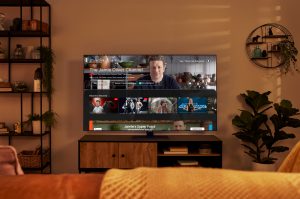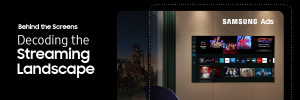
After more than 40 years of operation, DTVE is closing its doors and our website will no longer be updated daily. Thank you for all of your support.
Samsung Ads breaks down the current streaming landscape – but what does this mean for advertisers?
 Streaming enjoys exalted status as a favourite pastime. Debate around the optimal business model, however, continues to heat up. Disney+’s impending ad-supported model which is arriving in December (an attempt to cater to consumers’ desire for cheaper options) comes hot on the heels of Netflix’s ‘Basic with Ads’ subscription tier.
Streaming enjoys exalted status as a favourite pastime. Debate around the optimal business model, however, continues to heat up. Disney+’s impending ad-supported model which is arriving in December (an attempt to cater to consumers’ desire for cheaper options) comes hot on the heels of Netflix’s ‘Basic with Ads’ subscription tier.
 The subscription-funded model, so long the reliable framework for established subscription video-on-demand (SVOD) platforms, is seeing its dominance challenged. Multiple alternative video-on-demand (VOD) services have emerged to disrupt the status quo – these include:
The subscription-funded model, so long the reliable framework for established subscription video-on-demand (SVOD) platforms, is seeing its dominance challenged. Multiple alternative video-on-demand (VOD) services have emerged to disrupt the status quo – these include:
- Advertising video-on-demand (AVOD) – YouTube is the leading AVOD platform; free ad-supported TV (FAST) channels such as Rakuten and Samsung TV Plus are also competing for eyeballs.
- Broadcaster video-on-demand (BVOD) – BBC iPlayer, All 4 and ITV Hub are all notable examples
Samsung Ads’ latest report, Decoding the Streaming Landscape, observes streaming habits and expectations across EU5 markets – Italy, Spain, France, Germany and the UK. The report documents consumers’ changing behaviours over the past 12 months.
Consumers broaden their horizons
 The pandemic’s impact on the streaming landscape cannot be underestimated. Consumers – unable to go about their daily lives as usual – turned to their screens as a source of escape. Linear consumption fell behind streaming for the first time – a trend which has not changed since. Linear accounted for 48% of consumers’ total hours watched during H1 2022 – with streaming accounting for the other 52%.
The pandemic’s impact on the streaming landscape cannot be underestimated. Consumers – unable to go about their daily lives as usual – turned to their screens as a source of escape. Linear consumption fell behind streaming for the first time – a trend which has not changed since. Linear accounted for 48% of consumers’ total hours watched during H1 2022 – with streaming accounting for the other 52%.
Streaming audiences are perceived as ‘hard-to-reach’ for brands – particularly those exclusively using SVOD services. These audiences see paying a monthly fee as a fair price in return for access to large catalogues full of premium content.
So brand marketers cannot afford to miss incremental audiences that are unreachable with linear-only channels. Developing an in-depth understanding of continued consumer segmentation is vital.
Streaming’s soaring popularity isn’t the only noteworthy behavioural shift. Consumers have not always been receptive to ads and reasons why range from placement and frequency to relevance. But economic pressures are changing attitudes. Samsung Ads research revealed that 69% of UK consumers have acknowledged that consuming ads in exchange for free content is acceptable provided they are relevant.
Ads’ new-found power
Consumers’ increased acceptance has fuelled a dramatic rise in FAST services’ popularity – and they have quickly sent ripples across the industry. FAST’s user base increased by almost 10% between H1 2021-22, whilst the average monthly hours consumed rose by close to one-fifth.
Samsung TV Plus, launched in 2015, has quickly become the leading FAST service across EU5 markets. Its monthly viewership saw an 8% rise between H1 2021-22 – the average monthly hours consumed also enjoyed a 21% upturn during this period. Why Samsung TV Plus resonates with audiences more than alternative FAST services can be attributed to three core factors:
- Extensive catalogue of curated content which blends old television shows with popular genres such as news and sports
- Unrivalled accessibility – Samsung TV Plus is pre-programmed onto new Smart TVs
- Samsung’s global reputation as one of the foremost electronics and entertainment brands
The final point is particularly noteworthy. Smart TVs’ rapid sales growth has been instrumental in FAST channels becoming a prominent marketing asset. Smart TV penetration is forecast to reach more than half of all global households by 2026. This may be five years away – but it demonstrates the channels’ growing influence.
Ad-supported streaming – the future of advertising has arrived
Streaming giants’ decisions to venture into ad-funded subscription models won’t have been taken lightly. The need to navigate the current period of economic uncertainty has driven them to explore new avenues that can maintain audience engagement in a cost-effective manner.
FAST services in particular are beginning to play an important role in TV viewing thanks to the hybrid delivery of both on-demand and scheduled content – and consumers’ increased ad acceptance. With platforms such as Samsung TV Plus readily available and delivering seamless viewing experiences around the world, advertisers have the opportunity to reach their missing audience today.
 Click here to download the Decoding the Streaming Landscape report
Click here to download the Decoding the Streaming Landscape report
This is sponsored content.


